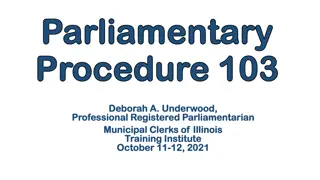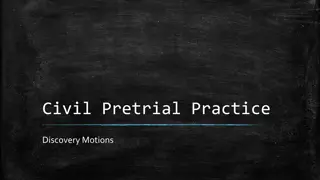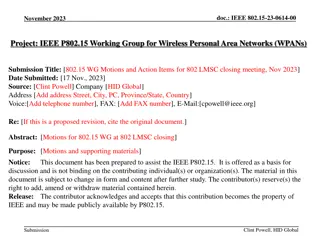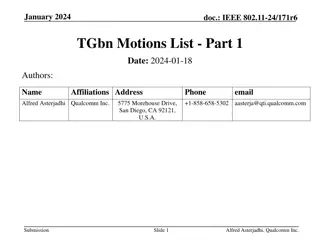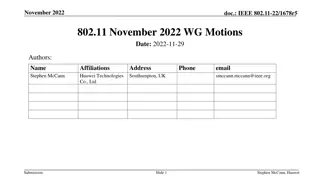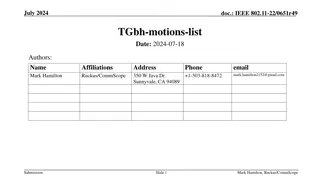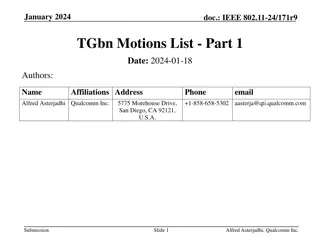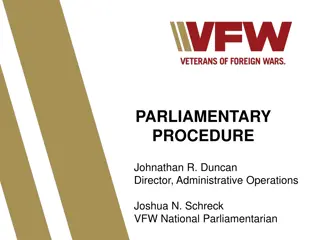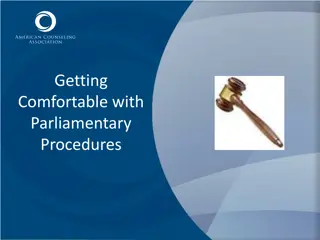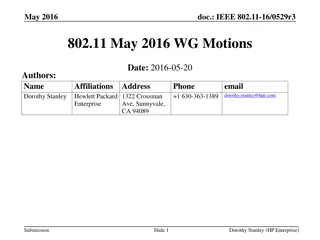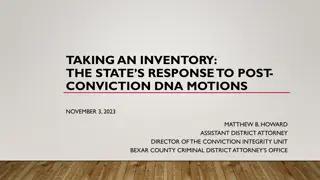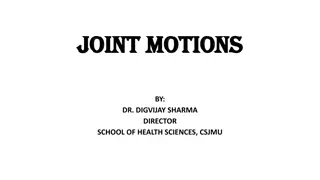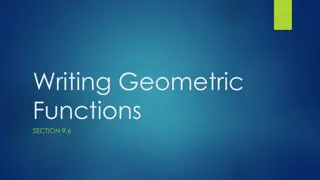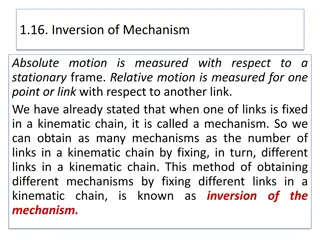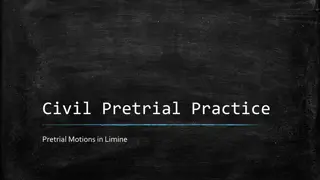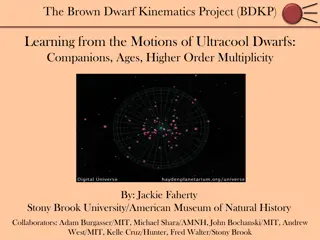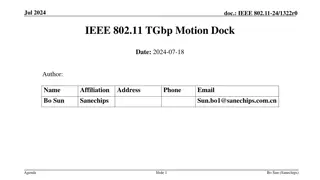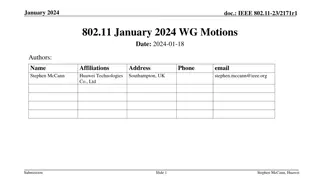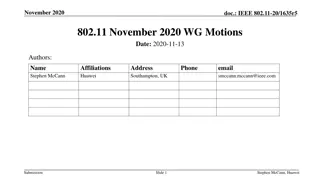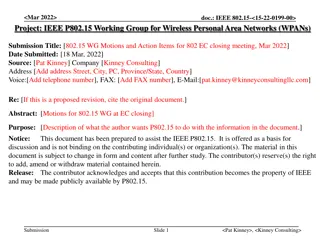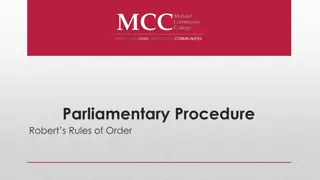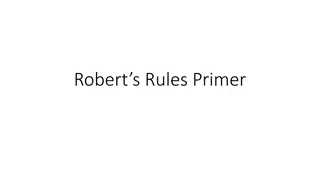Understanding Parliamentary Procedures and Motions
Explore the world of parliamentary procedures, motions, and resolutions in this comprehensive training session led by Deborah A. Underwood. Learn about different classes of motions, main motions, subsidiary motions, resolutions, and more, emphasizing the importance of order and efficiency in meetings.
Download Presentation

Please find below an Image/Link to download the presentation.
The content on the website is provided AS IS for your information and personal use only. It may not be sold, licensed, or shared on other websites without obtaining consent from the author. Download presentation by click this link. If you encounter any issues during the download, it is possible that the publisher has removed the file from their server.
E N D
Presentation Transcript
Parliamentary Parliamentary Procedure 102 Procedure 102 Deborah A. Underwood, Deborah A. Underwood, Professional Registered Parliamentarian Professional Registered Parliamentarian Municipal Clerks of Illinois Municipal Clerks of Illinois Training Institute Training Institute October 11 October 11- -12, 2021 12, 2021
Clerks World Clerk s World
Classes of Motions Classes of Motions
Classes of Motions Main motion Subsidiary Motions Privileged Motions Ranking Motions Non-Ranking Motions Incidental Motions Motions that Bring a Question Again Before the Assembly (Bring Back Motions)
Motions After a quorum is established, items of business on the agenda are handled by members offering motions. A subject is introduced by a member who makes a motion. After the motion is stated by the chair, the members discuss the motion.
The Main Motion A motion that is made when no other motions are pending. The main motion is the lowest ranking motion. Ranking motion #1 1. Original Main Motion Is a motion that introduces a question as a new subject to the assembly. RONR (12th ed.) 10:3 2. Incidental Main Motion A main motion that is incidental to or relates to the business of the assembly, or its past or future action. RONR (12th ed.) 10:4
Resolutions A complex question that is presented in writing either because of its importance or because of its length or complexity. Whereas, The (the first preamble clause). Whereas, The (the last preamble clause). Resolved, That (States the action to be taken). Resolved, That (States further action to be taken). Resolved, That (States still further action to be taken).
Subsidiary Motions A subsidiary motion assist the assembly in treating or disposing of a main motion. It is always applied to another motion while that motion is pending. Can be applied to any main motion. It is a ranking motion, so it follows the order of precedence.
POSTPONE INDEFINITELY Ranking Motion #2 Postpone Indefinitely is used to kill a main motion without a direct vote on it.
AMEND Ranking Motion #3 Amend is used to modify the wording or meaning of a motion by: 1. Inserting or adding words or a paragraph 2. Striking out words or a paragraph 3. Striking out and inserting words or substituting a paragraph.
COMMIT OR REFER Ranking Motion #4 Commit or refer is used to refer a motion or matter to a committee.
POSTPONE TO A CERTAIN TIME (or DEFINITELY) Ranking Motion #5 The motion Postpone to a Certain time (or Definitely) is used to defer action on a question to a definite time.
LIMIT OR EXTEND LIMITS OF DEBATE Ranking Motion #6 The motion Limit or Extend Limits of Debate is used to modify the number of speeches, the length of each speech, or the time for debate.
PREVIOUS QUESTION Ranking Motion #7 The motion Previous Question is used to stop debate and/or amendment on the pending question(s). It requires a two-thirds vote for its adoption.
LAY ON THE TABLE Ranking Motion #8 The motion Lay on the Table is the motion to make when you want to temporarily set aside the pending question to take up something more urgent.
Privileged Motions Deals with matters of immediate importance. Privileged motions do not relate to the pending business. Take precedence over all the lower ranking motions. (the main motion, all subsidiary motions, and lower ranking privileged motions)
CALL FOR THE ORDERS OF THE DAY Ranking Motion #9 Call for the Orders of the Day is the motion to call for a return to the scheduled order of business of the assembly.
RAISE A QUESTION OF PRIVILEGE Ranking Motion #10 The motion Raise a Question of Privilege is a question raised by a member that concerns the health, safety, or integrity of the member or the assembly.
RECESS Ranking Motion #11 Recess is a short intermission within a meeting.
ADJOURN Ranking Motion #12 Adjourn is a motion to end the meeting immediately.
FIX THE TIME TO WHICH TO ADJOURN Ranking Motion #13 The motion Fix the Time to Which to Adjourn is a motion to designating the time, and sometimes the place, before the next regular meeting of a continuation of the meeting in progress, because of the absence of a quorum or of a time constraint in order to complete business.
The Ranking Motions Lay on the Table Previous Question Limit or Extend Limits of Debate Postpone to a Certain Time/Definitely Commit or Refer Amend Postpone Indefinitely MAIN MOTION SUBSIDIARY MOTIONS
The Ranking Motions (contd) Fix the Time to Which to Adjourn Adjourn Recess Raise a Question of Privilege Call for the Orders of the Day PRIVILEGED MOTIONS
Incidental Motions An incidental motion is related to the parliamentary situation so that it must be decided before business can proceed. The apply only under special circumstances. Incidental motions are NOT ranking motions
The Non-Ranking Motions INCIDENTAL MOTIONS Point of Order Appeal Suspend the Rules Objection to the Consideration of a Question Division of a Question Consideration by Paragraph or Seriatim Division of the Assembly
The Non-Ranking Motions Motions Relating to Voting, Polls, and Nominations Parliamentary Inquiry Request for Information Request to Withdraw or Modify a Motion Request to Read Papers Request to be Excused from a Duty INCIDENTAL MOTIONS
Motions That Bring a Question Again Before the Assembly They allow the assembly to again consider the merits of a question that has previously been disposed of in some way. They are not ranking motions a.k.a. The Bring Back Motions
The Non-Ranking Motions MOTIONS THAT BRING A QUESTION AGAIN BEFORE THE ASSEMBLY Take from the Table Rescind or Amend Something Previously Adopted Discharge a Committee Reconsider
Standard Descriptive Characteristics Many of the most important rules governing the use of the individual motions are reduced to eight Standard Descriptive Characteristics. In addition to containing basic rules of procedure for each motion, these characteristics serve as points of comparison showing how the motion differs from a main motion.
Standard Descriptive Characteristics 1. Look at the rank of the motion. What motion(s) does it take precedence over or what motion(s) does it yield to 2. To what motions or types of situations it is applicable 3. Is it in order when another has the floor 4. Does it require a SECOND 5. Is it DEBATABLE 6. Is it AMENDABLE 7. What VOTE is required to adopt it 8. Can it be RECONSIDERED RONR (12th ed.) 7:1-3
Making A Motion A subject is introduced by a member who makes a motion beginning, I move The phrases I want to, I d like to, I motion, or So moved, does not introduce business in a meeting.
A Motion After a quorum is established, items of business on the agenda are handled by members offering motions. There are six steps to handling a motion.
Steps to Handling a Motion A Member MAKES a motion. Another member SECONDS the motion. The Chair STATES the question. Members DEBATE the motion. The Chair PUTS the question to a vote. The Chair ANNOUNCES the result.
Role Play Role Play
Resources Resources Robert s Rules of Order, Newly Revised 12th Edition Robert s Rules of Order, Newly Revised In Brief 3rd Edition Parliamentary Procedure in Local Government 3rd Edition


